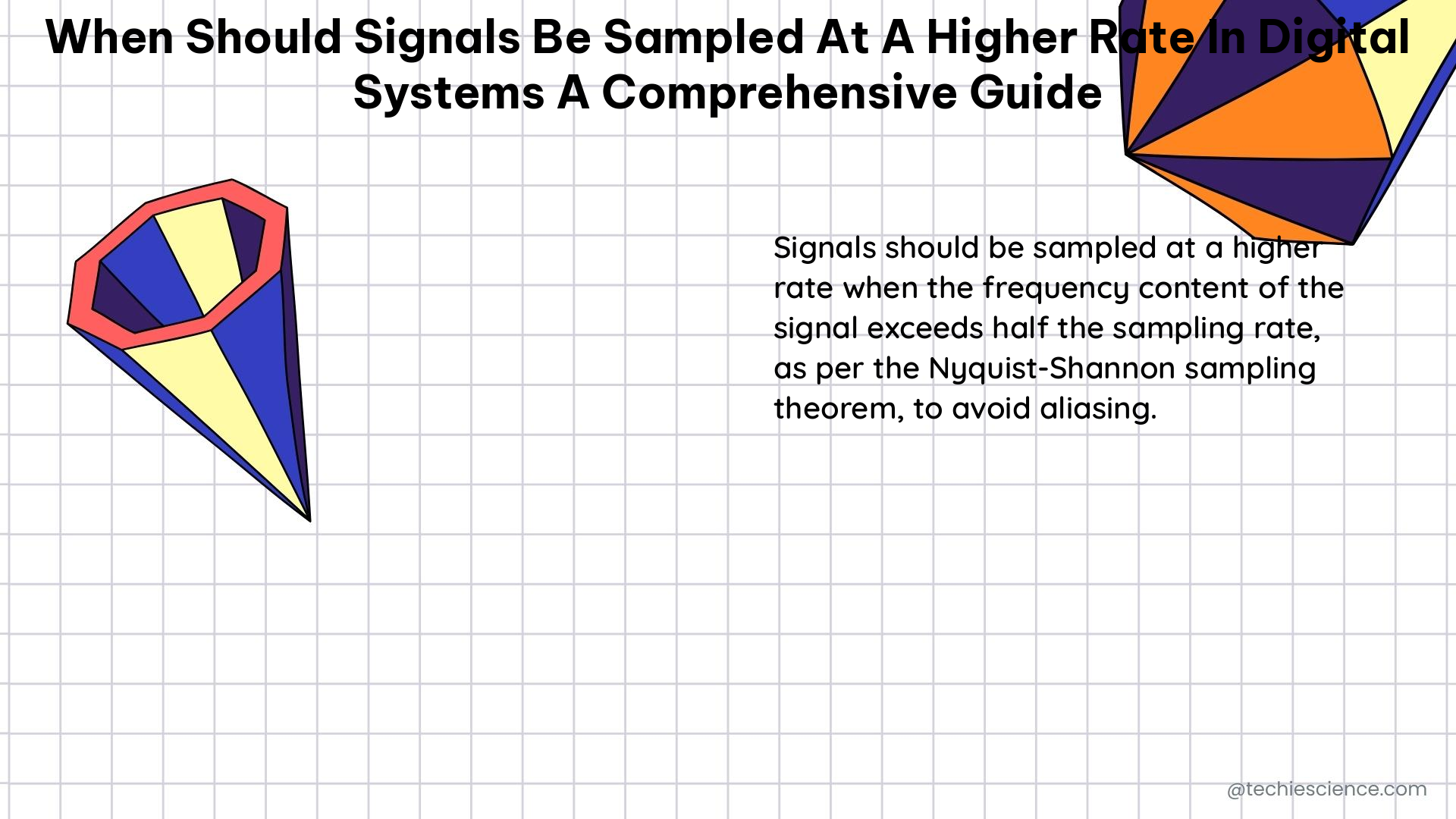The Nyquist-Shannon sampling theorem is the fundamental principle that determines when signals should be sampled at a higher rate in digital systems. This theorem states that a signal must be sampled at a rate that is at least twice the highest frequency component of the signal (fmax) to avoid aliasing, which can lead to distorted signals.
Understanding the Nyquist-Shannon Sampling Theorem
The Nyquist frequency (fN) is defined as half of the sampling rate (fs), and the maximum frequency range (Fmax) is determined by the sample rate, as Fmax = fN = fs/2. For example, a 44.1 kHz sampling rate allows for a frequency band representation from 0 to 22.05 kHz, while a 48 kHz sampling rate enables signals up to 24 kHz to be sampled.
In practice, a signal can never be perfectly bandlimited, and even if an ideal reconstruction could be made, the reconstructed signal would not be exactly the original signal. The error that corresponds to the failure of bandlimitation is referred to as aliasing.
Preventing Aliasing with Anti-Aliasing Filters

To prevent aliasing, anti-aliasing filters are used to remove components above the Nyquist frequency prior to sampling. These filters are designed to attenuate the signal components above the Nyquist frequency, ensuring that the sampled signal accurately represents the original signal.
Low-frequency aliases are still generated, but at very low amplitude levels and can be reconstructed without significant additional distortion.
Determining the Sampling Rate
In summary, signals should be sampled at a higher rate in digital systems when the highest frequency component of the signal (fmax) approaches or exceeds half of the current sampling rate (fs/2). Adhering to the Nyquist-Shannon sampling theorem and using anti-aliasing filters can help ensure accurate signal representation and prevent aliasing.
Nyquist-Shannon Sampling Theorem
- A signal must be sampled at a rate that is at least twice the highest frequency component of the signal (fmax) to avoid aliasing.
Electronics Formula: Sampling Rate
- The sampling rate (SR) is the number of times a signal is read in a second.
- The Nyquist frequency (Fmax) is determined by the sample rate, as Fmax = SR/2.
Electronics Example: Sampling Rate Calculation
- If a signal has a highest frequency component of 10 kHz, the minimum sampling rate required to avoid aliasing is 20 kHz.
Electronics Numerical Problems: Sampling Rate Calculation
- Problem 1: A signal has a highest frequency component of 15 kHz. What is the minimum sampling rate required to avoid aliasing?
- Solution: The minimum sampling rate required is 30 kHz.
Aliasing Diagram Example
- A signal is sampled every 200 microseconds, giving a sampling frequency of 5 kHz. The positive spectrum of the signal is shown in Figure 2.8.
- The Aliasing Diagram is shown in Figure 2.9, with the original spectrum in green, the resultant in red, and the other reflected spectrums in blue.
Factors to Consider when Determining Sampling Rate
When determining the appropriate sampling rate for a digital system, there are several factors to consider:
- Highest Frequency Component (fmax): The sampling rate must be at least twice the highest frequency component of the signal to avoid aliasing.
- Nyquist Frequency (fN): The Nyquist frequency is defined as half of the sampling rate (fN = fs/2). It represents the maximum frequency that can be accurately represented in the sampled signal.
- Bandwidth Requirements: The sampling rate must be high enough to capture the entire frequency range of the signal of interest.
- Signal Characteristics: The nature of the signal, such as its waveform, amplitude, and frequency content, can influence the required sampling rate.
- Hardware Limitations: The sampling rate may be limited by the capabilities of the analog-to-digital converter (ADC) or other hardware components in the digital system.
- Computational Resources: Higher sampling rates can increase the computational load on the digital system, so the available processing power and memory must be considered.
- Noise and Distortion: Sampling at a higher rate can help reduce the impact of noise and distortion in the sampled signal.
- Application Requirements: The specific requirements of the application, such as the desired signal quality, resolution, and dynamic range, can dictate the necessary sampling rate.
By carefully considering these factors, you can determine the appropriate sampling rate for your digital system to ensure accurate signal representation and prevent aliasing.
Conclusion
In conclusion, signals should be sampled at a higher rate in digital systems when the highest frequency component of the signal (fmax) approaches or exceeds half of the current sampling rate (fs/2). Adhering to the Nyquist-Shannon sampling theorem and using anti-aliasing filters are crucial to ensuring accurate signal representation and preventing aliasing. By understanding the principles and factors involved in determining the sampling rate, you can design and implement effective digital systems that can accurately capture and process the signals of interest.
References
- Sampling and Its Effects – Digital Signal Processing, https://kstatelibraries.pressbooks.pub/dsp-basics/chapter/sampling-and-its-effects/
- Ask the Expert: DSP and the Basics of Sampling – Dynaudio, https://dynaudio.com/magazine/2016/september/ask-the-expert-digital-signal-processing-and-the-basics-of-sampling
- Introduction – Sampling : Signal Digitalization – Ircam, https://support.ircam.fr/docs/AudioSculpt/3.0/co/Sampling.html
- The Sampling Theorem, https://www.dspguide.com/ch3/2.htm

The lambdageeks.com Core SME Team is a group of experienced subject matter experts from diverse scientific and technical fields including Physics, Chemistry, Technology,Electronics & Electrical Engineering, Automotive, Mechanical Engineering. Our team collaborates to create high-quality, well-researched articles on a wide range of science and technology topics for the lambdageeks.com website.
All Our Senior SME are having more than 7 Years of experience in the respective fields . They are either Working Industry Professionals or assocaited With different Universities. Refer Our Authors Page to get to know About our Core SMEs.